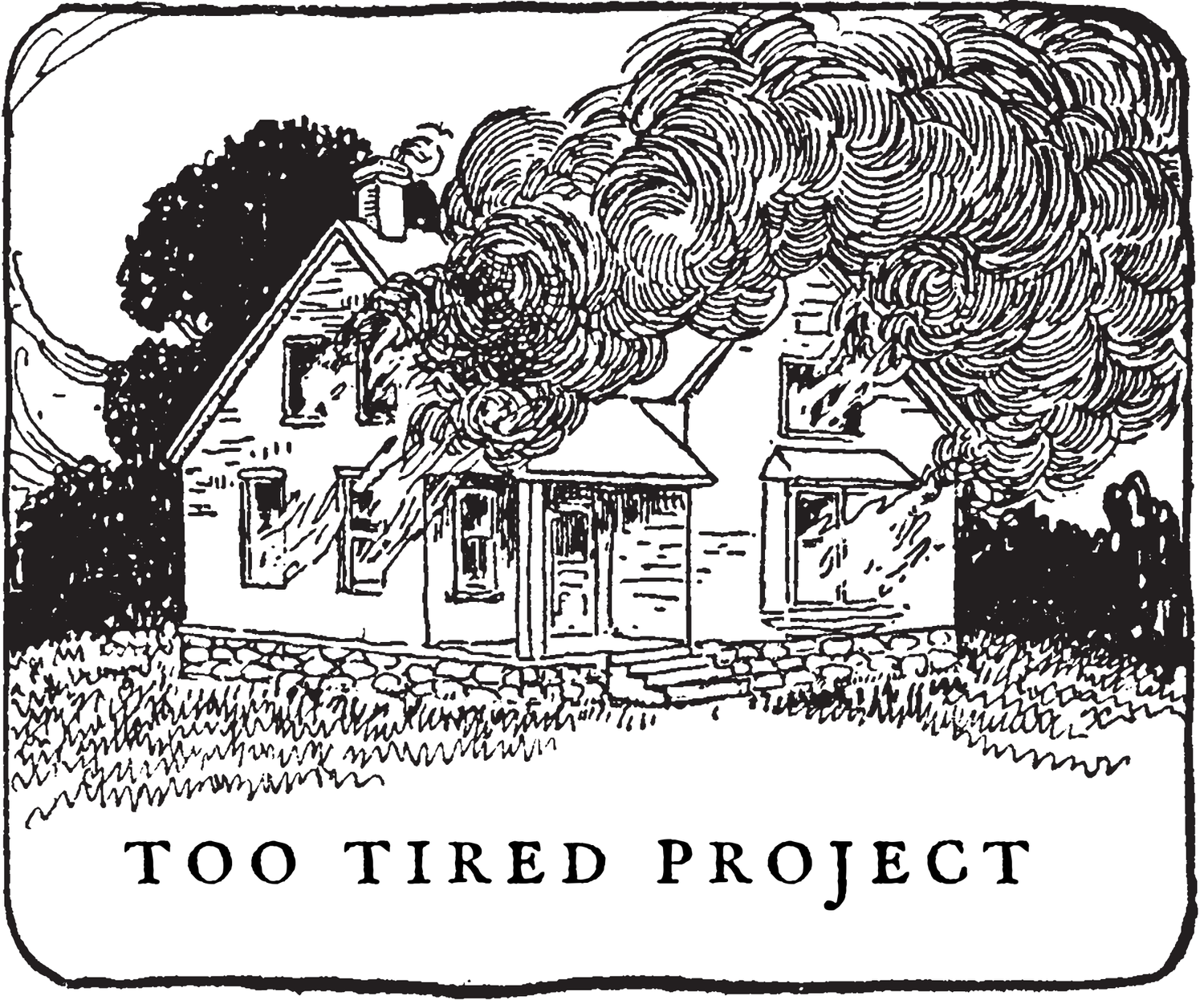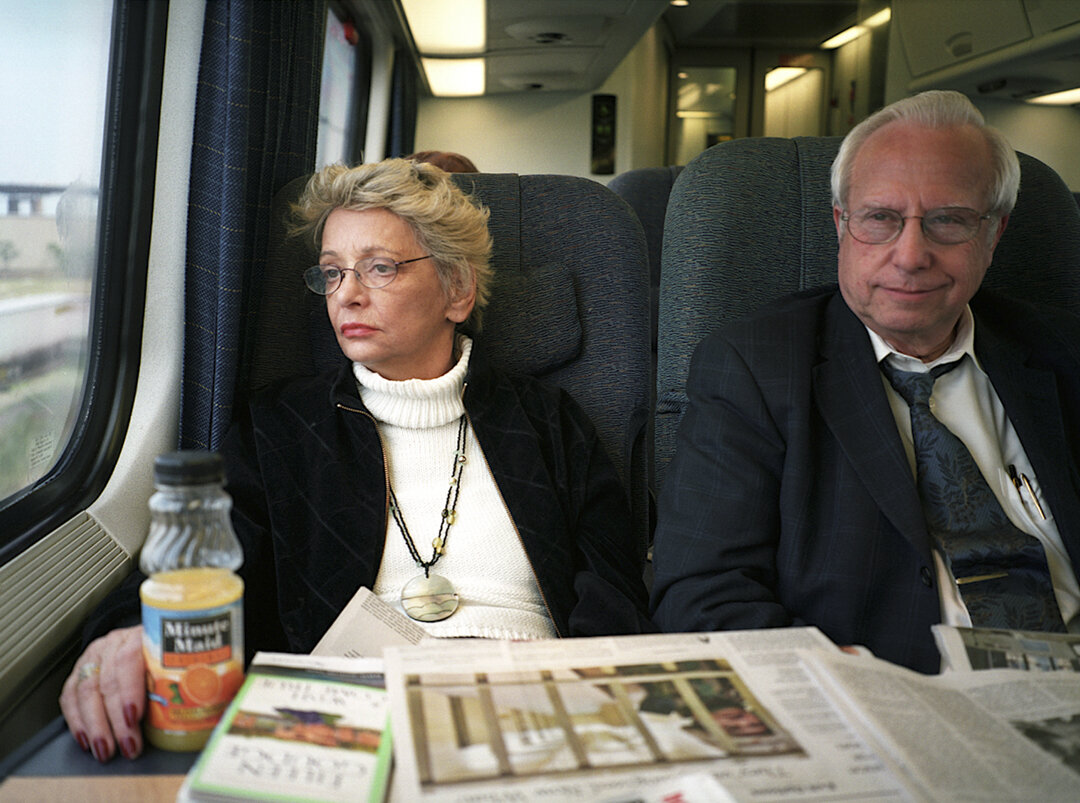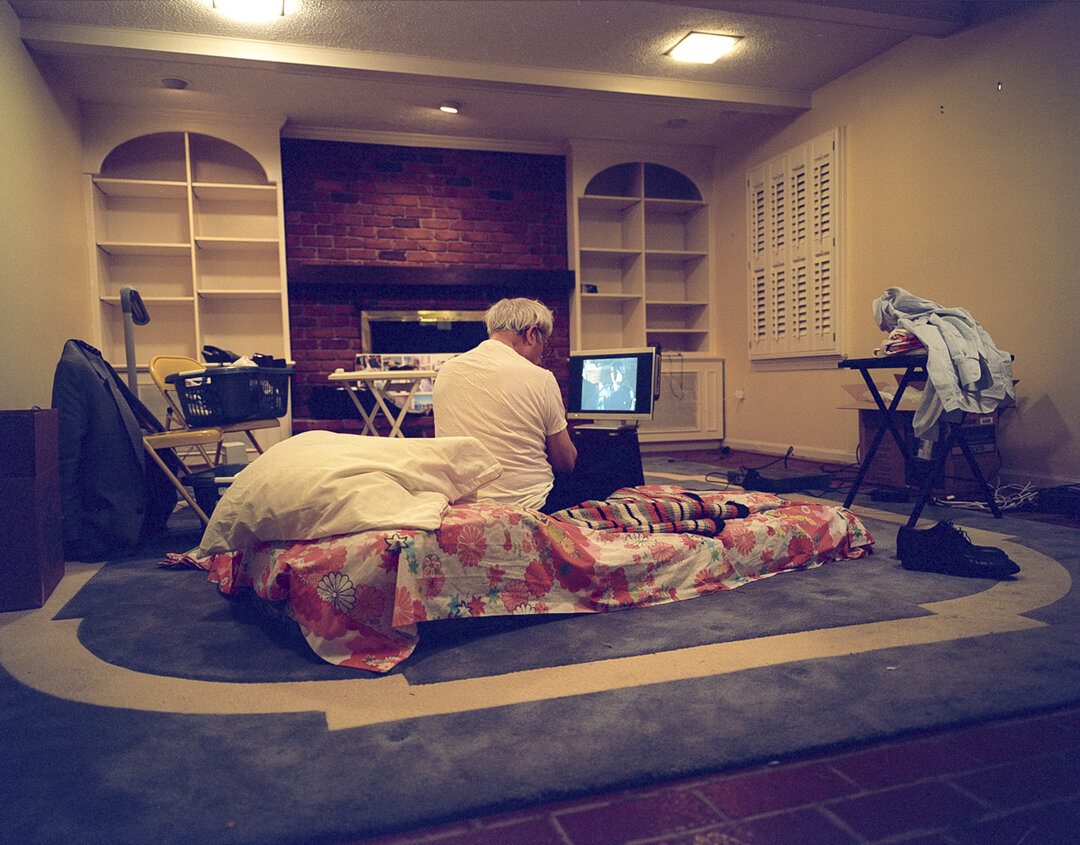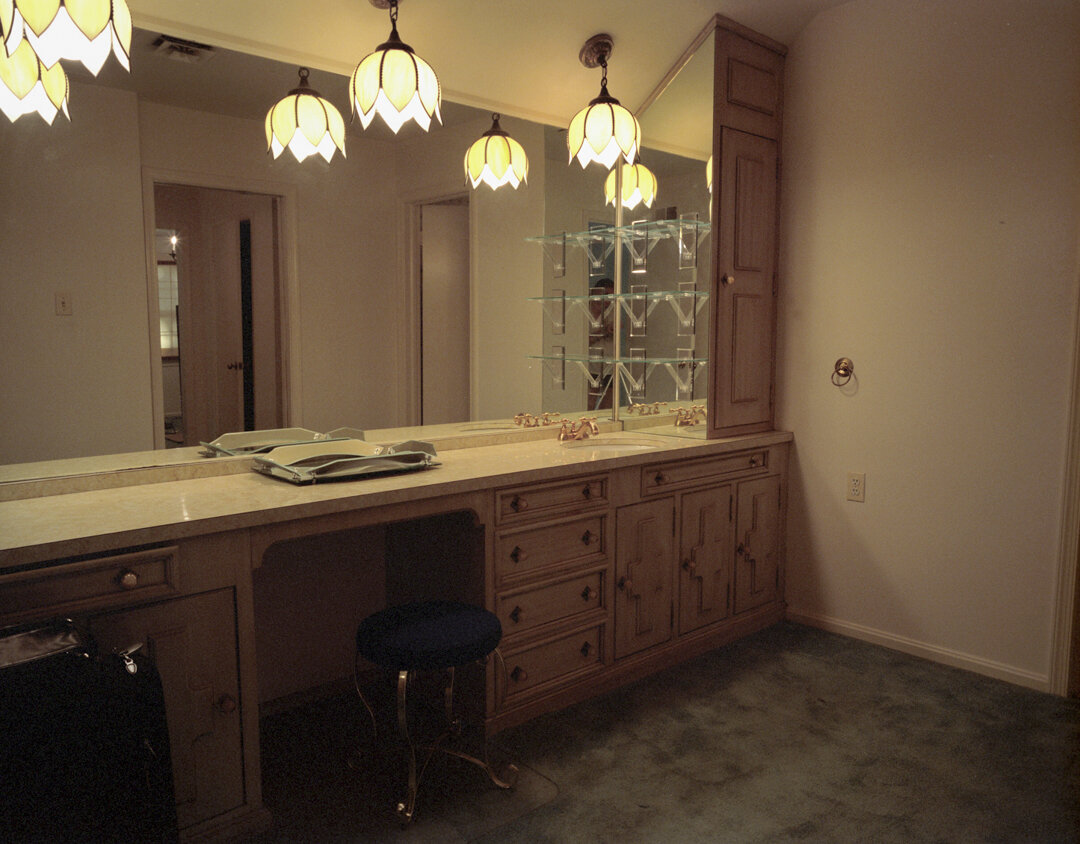Interview: Beth Chucker on her practice and “Ellie and Frank, Frank and Ellie”
Tell us about the project.
Ellie and Frank, Frank and Ellie
He met her on a blind date.
They went to the Shoreham Hotel.
Watched and listened to Sophie Tucker
He leaves
He returns
He smiles and says,
“I bet you thought I had left you.”
She smiles and states,
“You will never leave me,
you will marry me.”
I grew up with this love story of how my parents met. I always felt this was what held them together through years of doubt, years of just not liking each other, years of contradiction. I was proud to become their counselor, in the middle of them most of the time. We were a family of three. Finally, there was a point when their existence with each other became rooted, the resentment dissipated and their marriage became, Ellie and Frank, Frank and Ellie.
In 2002, I got married and I picked up my camera to create images that would talk about a sustained marriage and the space within that marriage; the distance that these two people have from one another even in close proximity. Turning the camera on them brought us together as a family. In having a task to achieve we all rallied together to make it work and to learn from the experience. I thought about how as a society we commonly try to find ways to stop the revolving patterns of our family; to form something totally different. Not strained, not boring, not lame, not grown up.
Photography is always a question about the photographer’s experience in life, Susan Sontag (In Plato’s Cave- On Photography) asks whether the photographer is hiding from their own experience when they are constantly behind the glass? I feel at times that I am hiding and experiencing life behind my chosen mask of the lens, but when it came to creating the images with my parents I know that if I had not started taking images of them, that the distance I felt they had with each other and maybe even me, could have continued. I am not saying my idea created closeness, but I do think it brought attention back to them and back to my mother’s statement 42 years before, “You will never leave.”
Ellie and Frank, Frank and Ellie started as a way to compare my closeness with my husband to my parents’ distance with each other, the work evolved as well as the photographer making the work. The image of my father cutting up my mother’s hospital food actually tells it all of their love for each other. The photographer (myself) knew intimately their history and strains on their relationship, I even once thought they should divorce. But in the last ten-plus years of my mother’s life, they allowed the fact that they actually grew old together to get them closer to each other emotionally.
My mother left us a list of what she wanted for her funeral, one of the things she stated was to make sure my father knew he was her prince. She had forgiven him for all the pain from the past, because that was just part of their history, now a blip. My Prince, I mean what an honor and heartbreaking. My father lost his life long messy wonderful family partner of 42 years. This part of the series ends with my father sitting on a makeshift bed in our family room where we used to all play Atari, watch Saturday Night Live and 6o minutes, have family gatherings, and my access to sneaking out at night. Here he sits watching TV as his back is curved and possible memories flood over him.
What is your process like?
My process is usually about the evolution from another idea. In the project of my parents, that was an evolution from looking at two marriages, one that was a year old and one that was 40 years old. But through my image-making and editing, I could see a shift in the work and in how I was looking at my parents’ marriage.
When I would be photographing either couple (my parents, myself, and my husband, I would set up the light and camera on a tripod in a desired composed spot. I would sort of wait to see what would happen within that frame naturally and then add a few extra images or similar frames to make sure I got the shot. In some instances with my parents, like at the hospital, it would just be my camera and no tripod. My camera (either the Mamyia 7 or Fuji 6:45 auto were my main camera- though there are square images speckled in the beginning) was always with me.
With my parents, they were obviously open to what I was doing, but in some images, I caught them off guard. For example the image of my mother in front of the mirror, she had stepped out of the shower and was not aware that I had set up the camera so I startled her a little.
Depending on the project most of the process is very similar, I like the idea that the images feel like a spy or a fly. I am also always looking for similarities within repeated images from different shooting times. In the beginning of Ellie and Frank, Frank and Ellie, you see them on the couch distant from either other 100 percent but a couple of years later you see them close and connected. I went back to my mom’s dressing room and photographed the empty room after we had the house packed up. I did this with other shots. Recently, I have compared images that I took back then to similar ones I have now.
I think there is this thing with me and connective imagery.
Does mental health or wellness factor into the creation of your work?
Since I graduated from Corcoran School of Art in 1994, I have made work that looks at depression or isolation. I made this work to project my feelings that were happening inside me but also to visually show what that may look like without an obvious label of (this is depression). I think that mental health always trickles into my work.
Even when I try to get away from mental health in my work, it comes back. When I started this body of work, I was getting my second degree from Art Center College of design and trying to focus more on commercial work. Then when I applied to grad school I was hoping to disrupt my internal monologue in my photography and point it towards other ideas I wanted to focus on (migration around the world, being one). Somehow with my writings in grad school, it led me back to the unfinished business I had with the other work. My work changed as all does, but there is an underlying theme of loss, depression, self-reflection, and family. I found new ways to tell stories while also talking about loss or identity or family or transition. Some are easy to see, the project on fertility “A Work In Progress” has this strong point of view from a tradition of documentary photography. But other projects, like “Mothers” and “Stroll Los Angeles” are more conceptual and possibly behind the emotional scenes of loss and depression.
How did you begin this project?
This project actually started while I was taking a class with Eve Fowler. I was looking to document images that gave me calm. I came back with a bunch of mixed imagery and she honed in on some images of my parents. She was so intrigued by how distant they were, which led me to discuss openly about their relationship and what I thought I knew at that point. But didn’t want to just photograph them, I wanted to see how it compared with my own marriage. In the first edit of the project, there are these funny comparisons, my father sitting watching TV and my husband sitting watching TV, a classic you marry your father. But then there is the image of just my mother’s side of the bed and one of my husband and I in an embrace on our bed, showing her loneliness and our connectedness. Though I took out the images of my husband and I, comparing the two marriages began to seem not far to my parents. Like I was better than them, no.
Was the process of creating this project helpful for dealing with the emotion you’re describing in your images?
I think the process helped me really see the complexity of my parents’ marriage and what marriage is, complex and work. I think it also helped me with my own anxiety about marriage and being in a committed relationship.
But because my mother was sick at the time (I was trying not to make that the focus of the work) I think focusing on them and her was prominent. It's hard to quantify because my father and I were both in denial of how sick she was. We wanted to keep her here. Actually, at this point in my life, I was making work but I could not set out to put my work out there to be seen. I could say this pattern continued for a few years until I put myself into grad school.
After my mother died, I still made work about my parents and it helped me to keep focus, keep her close, and to live in the grieving. I think as a whole we try to get past grieving as quickly as possible. But for once my sadness was something I could quantify. I could understand why my mental state was tired, looking for connection, needing and deserving escapism. This time also allowed my father and I to grieve together by working together and talk about her within making work or looking at the work. Later in grad school, my thesis would be on making work about grief and the different ingredients we consciously or subconsciously use to cope.
Four months after my mother died, I lost a very close (sister-like) family friend to suicide. She was in the process of grief too. Grief from her father’s death, grief from my mother’s, and a recent breakup. We had been both feeling the weight of that grief and when she died, I spiraled. But that is when travel kicked in and I had to go and shoot.
Coming home from travel or helping my father, my process helped me and gave me purpose. But I also think I am lucky that I could sit with these images and edit and print and think of their purpose and story.
How are you affected by the natural world that you see day-to-day?
I would not say I am a naturalist. I do not go seek out the highest mountain. I am more of a city person at heart, looking for the natural world in it. All that being said, being out in the world and looking at the mundane and seeing beauty is very much something I love to do. Since we have been in lockdown, when we are able to go out and be in the world I always feel energized and I have noticed it more. I now crave to make those adventures outside with the natural world.
How am I affected, on a rainy day I could get motivated because of the romanticism of a rainy day and the quiet it brings, on a sunny day (well I lived in LA for about 17 years so I was spoiled and disillusioned) I do find that energy and welcome it, but I do not run outside for the need to be there. Cold can get to me, but this year with all the snow and finally some correct warm gear I was able to really enjoy it, take images, be present and watch my kids. Sledding is my new jam.
Light is really everything, and as photographers, we know that light is not just a bright blaring sun on us. I do love examining all kinds of light and helping to use it for the right purpose for the image.
What is your relationship to photography?
A long love affair that maybe not always loved me back. I have wondered for the last few years if I should stop my pursuit of a career in photography. But it is my purist voice, it is a place that can articulate me. I really love getting into a zone just to be all about photography. I love making work, playing with images, thinking about new images, reading about photography artists and their process, talking to people in the photo world. But it’s tough and I have taken a very long road to get to where I would have wanted to be. I remember back in grad school there was a point where we were questioning photography because of what had been done before, has photography become over-saturated, can you push those boundaries that artists of the past have? I still question that within my own practice because I see people who collage and create an amazing language with their creations in photography and then I look at my more traditional approach in telling a story or a thought and wonder (as my thought trails off).
Has the pandemic shifted the way you approach your work and/or photography at all?
Not really, it has pulled me back to focusing on getting my work back out in the world. I mostly shoot what is in my proximity and I focus on my family. But there was an obvious shift because there was a shift in all of us. I did not find myself super motivated to make a new category of work (pandemic related “themed”), though my brain was on fire and had ideas, there was an increased lull. I would photograph us (my family) in quarantine and early days the depression that was hitting us. But we have adapted some, hit walls on other days and my own slow production is still here (I was hoping for that energy that many got to make bread or just make stuff).
It was also daunting because ideas that were reaching me were reaching others, photographing people from a distance or on zoom. I love these projects and the support they gave by raising money, I wish I was that person, that go-getter who makes things happen. Seeing that did put me into questioning myself and actually seeking therapy again.
The pandemic also has shown me that I need a community around me of my peers to keep my drive going. I have taken a couple of small workshops to re-introduce myself to the photo community and hopefully build new connections.
I have also been playing more with process, but the process is with phone apps and using them to obstruct the images. These images are not fully resolved yet.
Thank you so much to Beth Chucker for sitting down with Too Tired Project. You can explore more of her work on her website.









